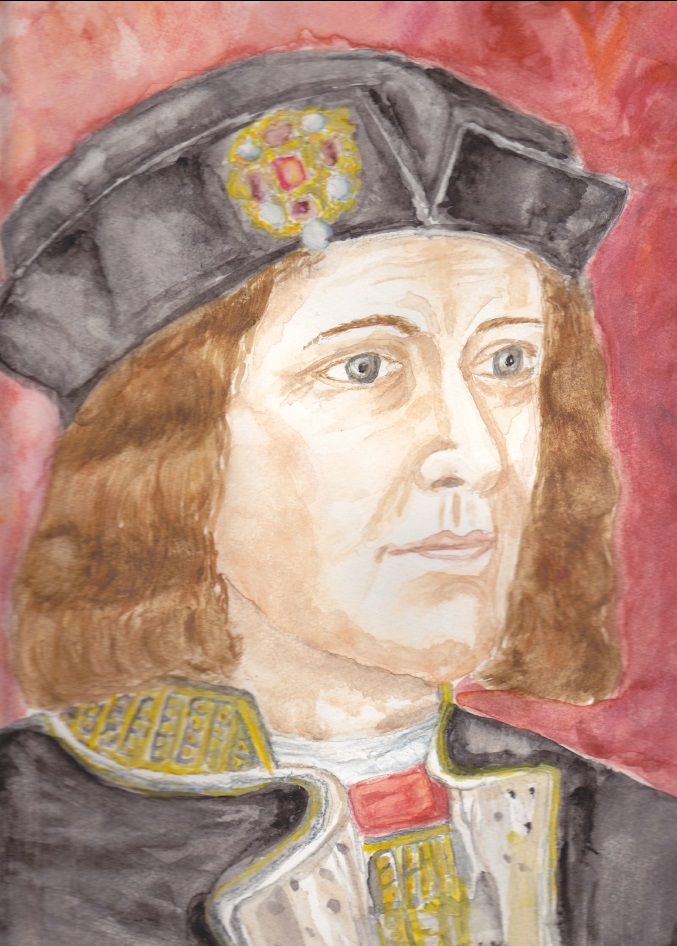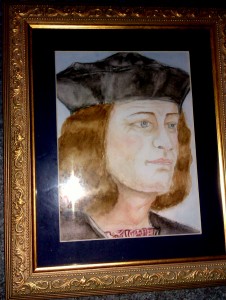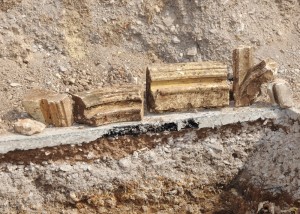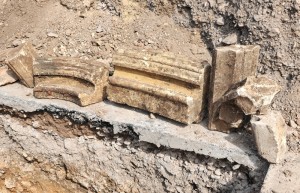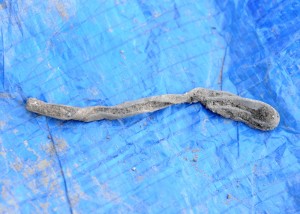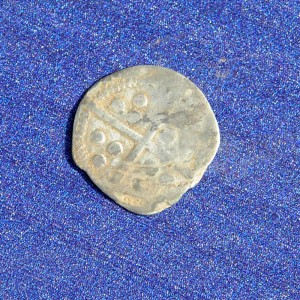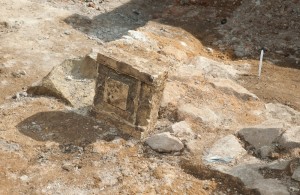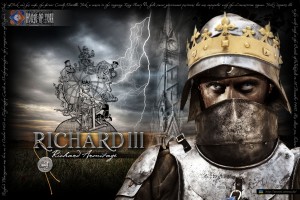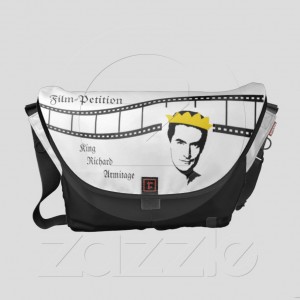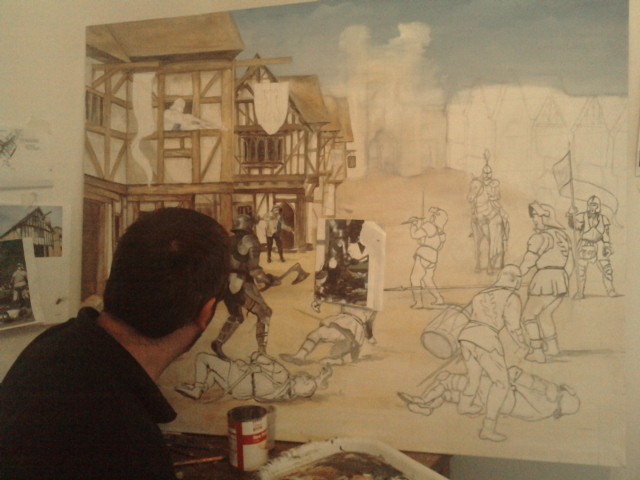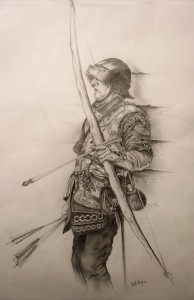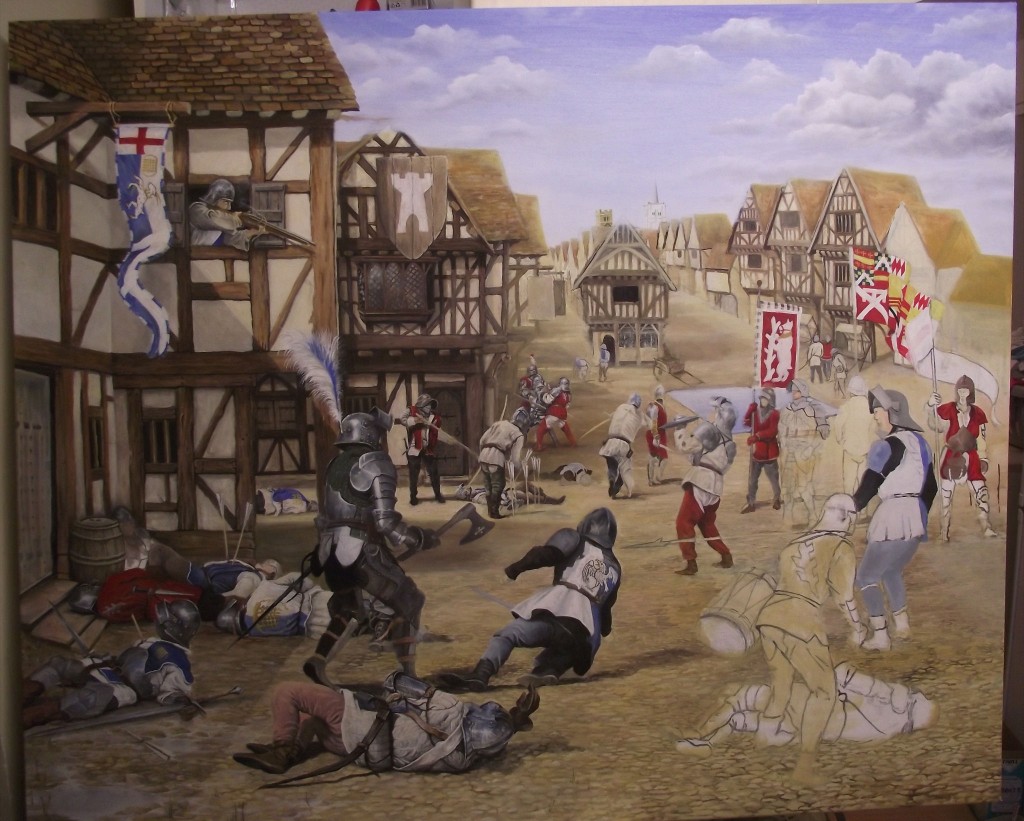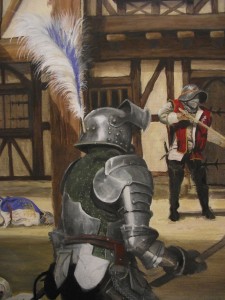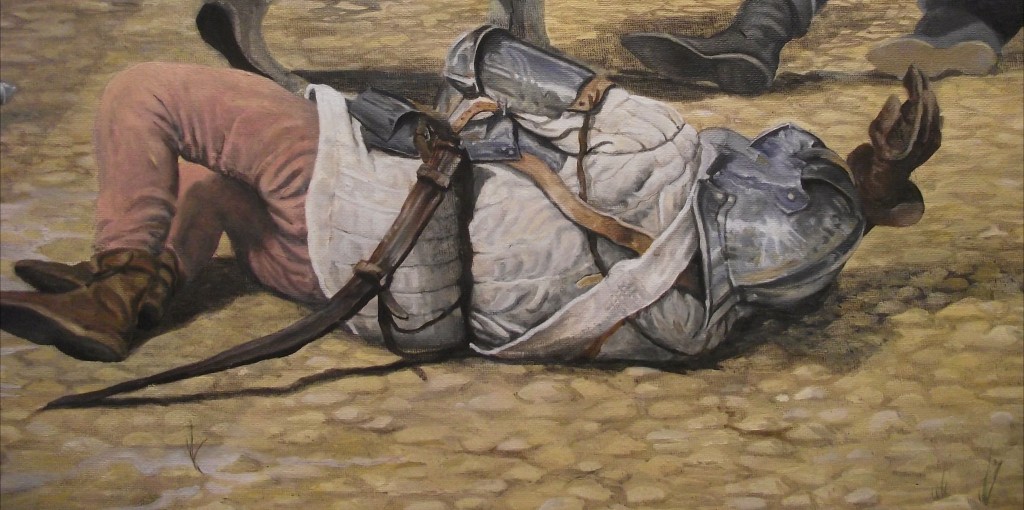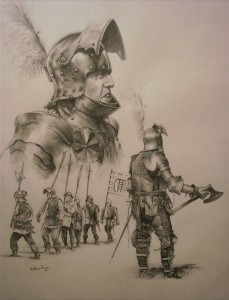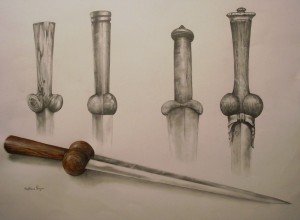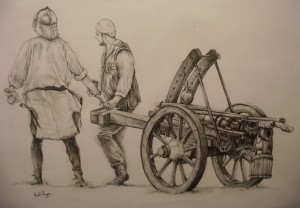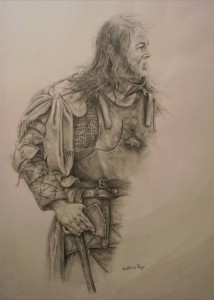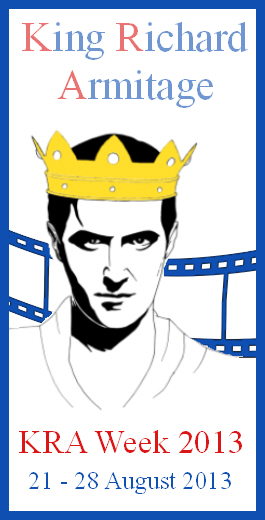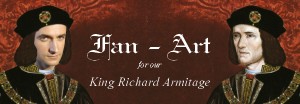King Richard III News – Long Overdue Updates
I am most certainly behind with reporting about the King Richard news.
Real life intervenes quite heavily right now. Sorry. I will try my best to keep up with the news.
But now here comes the news collected in the meantime since I fell off the plateau of the earth:
(Due to its length, the articles are arranged in a changed order – from new to old news.)
♛ King Richard Armitage ♛
Our king, Richard Armitage, will visit Berlin, the German capital, for the European premiere of the second “Hobbit” film “The Desolation of Smaug” on Monday, 9th of December 2013.
For this event a Bavarian FanClub banner was created to welcome Richard Armitage in Germany and celebrate ‘our king’:
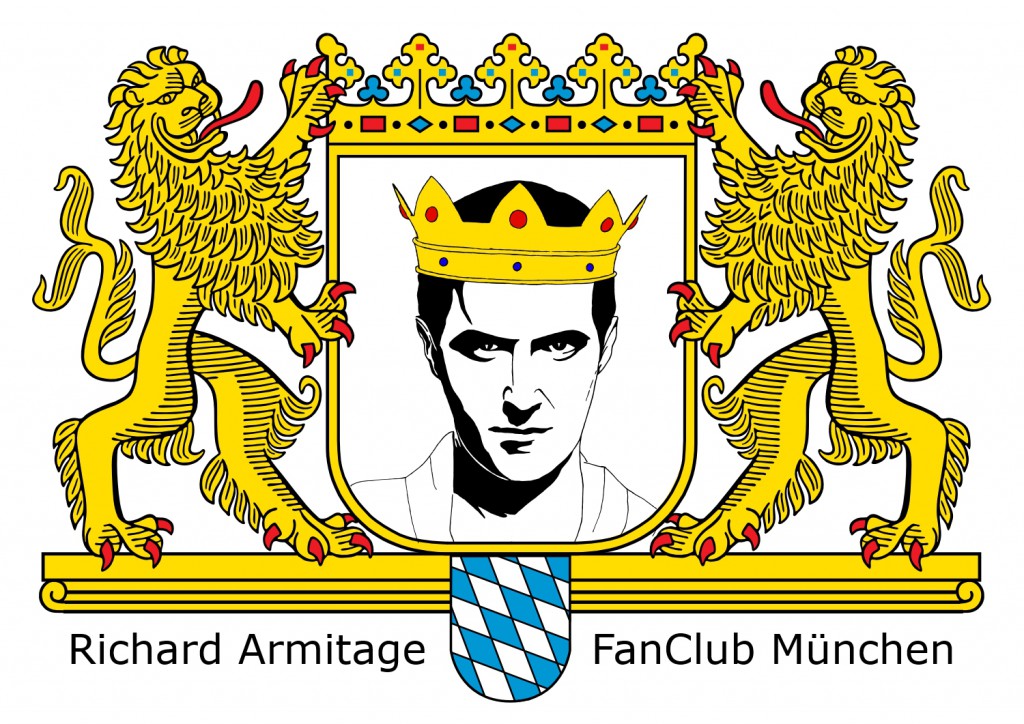
- Leicester Mercury: Hollywood star Richard Armitage donates signed art for Loros hospice auction (07.12.2013) – The auction takes place at the Old Library, in Belvoir Street, Leicester on Sunday, 8th of December 2013.
♛ King Richard III ♛
- The Observer: Philippa Langley: I just felt I was walking on Richard III’s grave. I can’t explain it’, by Elizabeth Day (08.12.2013) – A long overdue article trying to set the perception of the events leading to the discovery of King Richard III and the energy put into it by Philippa Langley right.
- Leicester Mercury: Richard III exhibition welcomes 150,000th visitor at the weekend, by Peter Warzynski (03.12.2013)
- Belfast Telegraph: Belfast-based academic’s radiocarbon work to improve accuracy for archaeologists, environmental scientists and climate researchers, by Anna Maguire (03.12.2013) – Contrary to this article, I had been of the opinion that the find of King Richard III is the unique opportunity in history to adjust and calibrate the scientific methods and not the other way around, as rarely a case occurs where the exact date of burial is so well known as with King Richard III.
- Professional Jeweller: Steffans and Theo Fennell team for tribute to king, by Kathryn Bishop (02.12.2013) – Some morbid jewellery in a King Richard III line created by British jewellers.
- InLoughborough: University of Leicester wins Research Project of the Year for Dig for Richard III (01.12.2013)
- Leicester Mercury: Richard III: University of Leicester and city council meet to discuss custodian issues, by Peter Warzynski (30.11.2013)
- ITV.com: Car-park King dig earns Leicester Uni top prize (29.11.2013) – King Richard III patronising universities again – first Cambridge, now Leicester?
- University of Leicester: University of Leicester wins Research Project of the Year for Dig for Richard III (29.11.2013)
- Leicester Mercury: Leicester City Council and university at odds over who owns Richard III’s bones, by Peter Warzynski (28.11.2013) – Leicester against York and now Leicester against Leicester? It really seems like a revival of the Wars of the Roses.
- Metro.co.uk: Here’s a solution to the Richard III standoff: Share his remains, by Alex Stevenson (27.11.2013) – Now, the idea is not so farfetched for someone who went to school in a town, where all the hearts of the Bavarian kings are buried – or rather should I say, (did) ‘hang around’. Though for a late medieval king with religious beliefs of the untouchable sanctity of the human body, that is not the best of choices. Why else do you think they cut off limbs to prevent criminals from getting into heaven? I hope, wherever they bury him, they bury at least a bit of his ashes together with his bones – you know, the heart…
- TheDailyBeast (Blog): Times Leader Writers Can’t Decide Where Richard III Should Be Buried, by Tom Sykes (27.11.2013) – Now it is clearly decided where King Richard III should be buried. We follow The Times’ suggestion(s).
- Leicester Mercury: Richard III: High Court legal battle adjourned until 2014 (27.11.2013)
- United Press International (UPI): British High Court delays legal fight over burial place of Richard III (27.11.2013)
- BBC History Extra: Richard III reburial battle ‘could drag on until August’, by Emma McFarnon (27.11.2013)
- Mirror.co.uk: Richard III: 10 things you need to know as battle over his final resting place hits court, by Andy Rudd (26.11.2013) – Your essential starting point for looking deeper into the story of King Richard III.
- The Independent: Wars of the Roses Part 2: High Court battle over burial of Richard III set to continue as case is adjourned, by Adam Withnall (26.11.2013)
- The Guardian: Battle for Richard III reburial site on hold as high court case is adjourned, by James Meikle (26.11.2013)
- BBC History Extra: Richard III judicial review adjourned, by Emma McFarnon (26.11.2013)
- The Lawyer: Richard III judicial review postponed, by Joanne Harris (26.11.2013)
- The Lawyer: Richard III JR hits court before three-judge panel, by Joanne Harris (26.11.2013)
- BBC History Extra: Richard III: Leicester reburial to be judicially reviewed tomorrow, by Emma McFarnon (25.11.2013)
- BBC News: Court battle for King Richard III’s remains to be buried in Leicester (25.11.2013) – With video and opinions of citizens of York and Leicester.
- University of Leicester: University of Leicester offers free course on Richard III’s England (25.11.2013) – The course was so successful that all available 10.000 places are full this time. If you did not get on the course this time, you have a new chance to attend the next course some time midsummer 2014.
- Express: £30,000 down and now taxpayers are to fork out more for King Richard III’s grave, by Matt Gibson (24.11.2013)
- University of Leicester: Queen’s Anniversary Prize to University of Leicester for Discovery of Richard III (22.11.2013) – Royal recognition for the exceptional find of King Richard III by the University of Leicester. Well deserved! Congratulations !
- RoyalCentral (Blog): University of Oxford academic suggests how Richard III could be reburied, by Jessica Hope (22.11.2013) – Research into the way Medieval kings used to be buried by Alexandra Buckle could give essential hints what to do now with King Richard III.
- BBC News: Giving Richard III a reburial fit for a medieval king, by Sean Coughlan (22.11.2013) – Interesting presentation of the research by Dr. Alexandra Buckle, from St Anne’s and St Hilda’s colleges into Medieval burial practices.
- STV.tv: Forensic team that helped reconstruct face of Richard III honoured (22.11.2013) – Prestigious award for the forensic team that helped to re-construe King Richard III’s face.
- The Guardian: Why Chris Grayling should bury his appeal against Richard III ruling, by Joshua Rozenberg (15.11.2013) – The old battle between moral and money – true in King Richard’s time, true now. Who will have the longer breath in the legal battle, whoever has the moral right? Who knows, who will ever know, now that it is the matter of a legal battle?
- University of Leicester: ‘Beyond reasonable doubt’: archaeologists give first-hand account of Richard III discovery in new book, by Peter Thorley (04.11.2013)
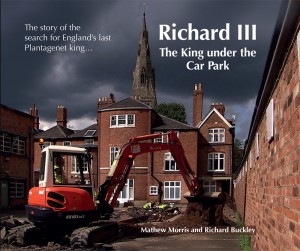
Mathew Morris & Richard Buckley: Richard III. The King under the Car Park. The story of the search for England’s last Plantagenet king…
- AnimeNewsNetwork.com: Otomen’s Kanno Adapts Shakespeare’s Richard III as Manga Series (03.11.2013) – Shakespeare’s King Richard III lives on in manga now.
- University of Leicester: Greyfriars Fine Foods launches range that’s fit for a king (01.11.2013) – Though I am rather doubtful that King Richard III himself came anywhere near such kind of food, here is the direct link to the delicacies: Greyfriars Fine Foods
- Dorset Echo: King Richard III stayed at Bridport (01.11.2013) – Arthur Woodgate discovered Bridport’s connections with Richard III. To celebrate this connection, Philippa Langley and Michael Jones will visit Bridport on Thursday November 14 (The Bull at 2.30pm) as part of the Bridport Literary Festival.
- Lambeth Palace Library: Books and their Owners II: The Hours of Richard III (11.10.2013)
KRA-Week 2013-5: Fitzg – Sumptuary Laws
Links: King Richard Week 2013 & Quiz
♕ ♛ ♕
SUMPTUARY
Sumptuary laws
in Medieval and late medieval England.
(by Fitzg)
“Laws made for the purpose of restraining luxury or extravagance, particularly against inordinate expenditure in the matter of apparel, food, furniture etc.”
Black’s Law Dictionary.
English Sumptuary Laws date from 1281 in extant documents. They were then an expression of the Feudal System (every man in his place, dressed according his station. Women too.) The hierarchy must be established according to the “natural law”.
The next documented Law is that of 1309. This relates to conspicuous food consumptions of the nobles. (Peacocks presented at table, complete with feathers re-attached to the roasted fowl…)
Perhaps Edward III felt that such expenditure by his magnates reduced their monetary contributions to his Scottish and overseas wars.
Obviously, Kings and their families were not restricted by such fiscal management restraints.
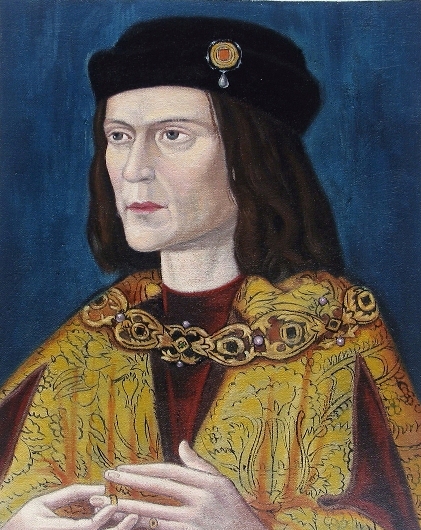
cloth of gold – Richard III earliest known copy of original; dated early 16th century (Source: Society of Antiquaries, London – Wikipedia)
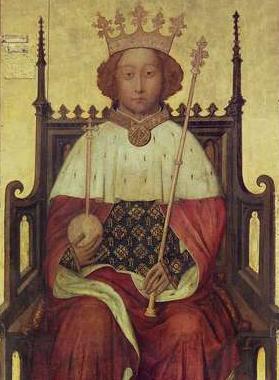
Richard II, c. 1390s. (Source: Westminster Abbey – Wikipedia)
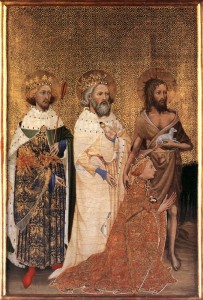
Wilton Diptych (Source: National Portrait Gallery, London – Wikipedia)
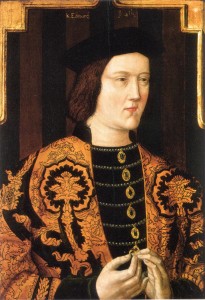
Edward IV. Portrait early 16th century (Source: Society of Antiquaries – Wikipedia)

Henry VII, c. 1505 (Source: National Portrait Gallery, London – Wikipedia)
Cloth of gold, fur, gold…. It appears that the first Tudor, despite a somewhat austere, penny-pinching reputation, at least in the popular version, was not averse to personal display.
However, there was considerable Church disapproval of courtly display of fashion “trends“. Shoes, in 15th C, were an issue with the Church: the vanity of the elongated toes.
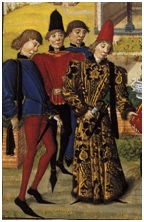 |
 |
 |
And then, there was the Disney head dress. The Henin, and variations thereof.
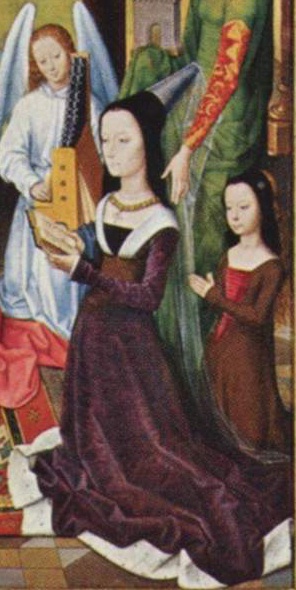
Hans Memling, Lady Donne of Kidwelly. The Donne Triptych, c. 1478 (Source: Wikipedia)
The middle class was rising in wealth, and becoming uppity in dress. Note the quantities of costly material in the sleeves and gowns and richness of dyes.
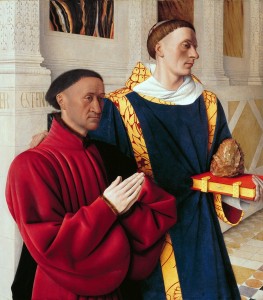
Hans Fouquet, the Melun Dipptych, c. 1452 (Source: Wikipedia)
Etienne Chevalier, was not a merchant, but a trusted civil servant.

The Arnolfini Wedding, Jan van Eyck, c. 1434 – Italian merchant and his wife (Source: National Portrait Gallery, London – Wikipedia)
Disconcertingly to the “enforcers” of the Sumptuary Laws, the merchant class rose inexorably. The merchant class accumulated wealth, based on wool and textiles, and import/export. They bought off the enforcers’ fines, and even lent funds to cash-strapped nobility. They were going to wear what they had earned. Their wives (and often mercantile partners/supporters) were an advertisement to their wealth and their often mutual hard work. (Take that, Enforcers! 😀 )
England has not been quite as rigidly class-ridden as might be thought – upward mobility was mobilised. From 15th century sheep farmers, the Churchills were Dukes of Marlborough two centuries later. A middle class was firmly rising throughout Europe, driven by trade – wool/textiles/luxury goods from the East. The sheep farmers became merchants (and money-lenders), married into gentry and titled families, became senior civil servants.
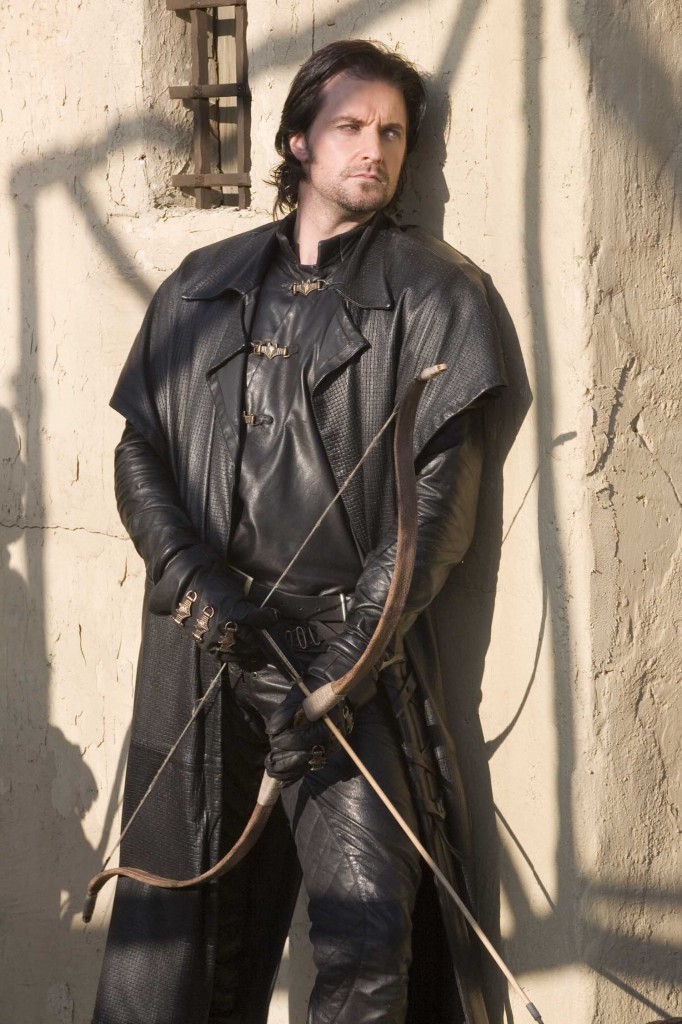
BBC “Robin Hood” Guy of Gisborne (Source: RichardArmitageNet.com)
Sir Guy of Gisborne, dressed head to toe in costly leather. Would a minor knight, in possession of an obscure provincial manor, pass the Sumptuary laws? Leather tanning and production were extremely costly, as is the case today. Perhaps; it didn’t involve cloth of gold or furs….
And Many Happy Returns to Richard Armitage on August 22 2013.
Respects to King Richard III, may he please be laid to rest as befits an anointed monarch.
SOURCES (for the costume-obsessed)
- www.medieval-life-and-times.info-medieval-clothing/medieval-sumptuary-laws.htm
- www.medieval-castle-siege-weapons.com/medieval-clothing.htm
- www.batashoemuseum.ca/collections/permanent/history_western_fashions/medieval/index.hstml
- Boucher, Francois. 20,000 Years of Fashion; Henry H. Abrams Inc. New York.
Links: King Richard Week 2013 & Quiz
A Late Medieval King in Modern Times
A Medieval King certainly needs an impressive royal portrait. Unfortunately, King Richard III was a bit under represented in the art of his time, which might be due to the fact that his successor King Henry VII was not all too fond of his image.
Now with a bust re-constructed from King Richard III’s skull, we can rectify that.
LDixon157 based her portrait on the new research as well as on one of the earliest surviving portraits painted after his death and created an impressive royal portrait of King Richard III:
LDixon157
contributed her wonderful water colour painting of King Richard III.
See more of her work here: LDixon157 on Flickr
♛ King Richard III ♛
King Richard III is found, but still, lots of questions remain to be answered. Only one of those questions is, where King Richard III should be buried. Though a fast answer seems unlikely, now that this question goes to court and an answer to this delicate problem of ancestry, relation and prerogative of distant descendants needs to be found there.
- University of Leicester: Archaeology Team Bids to Extend Search at Historic Church Site (30.04.2013) – The archaeological Sevices of the University of Leicester have applied to the Ministry of Justice for a further exhumation licence (a stone coffin has been found, presumed to be of a medieval knight called Sir William Moton, buried at Grey Friars Chruch in 1362) and to the City Council, to extend the previous dig and find out more about the Church of the Grey Friars where King Richard III was buried.
City Mayor Peter Soulsby about the digging request:Our aim is for the gravesite located within 6-8 St Martins to become part of the new visitor centre, and the removal of part of the wall will be necessary to make this happen. This application is therefore a step forward in the development of the site.
The archaeological excavation is planned to start at the beginning of July 2013 and will last about 4 weeks. The public is intended to get opportunity to see the work in progress.
- The York Press: Richard III legal fight to start next week, by Kate Liptrot (27.04.2013)
- Green Valley News & Sun: Genealogy Today: Richard III reinterment in dispute, by Betty Malesky (28.04.13) – Discussions that King Richard III’s grave should show his good and bad sides, just do not get my full support. For one, who are we to decide which one’s of his sides were which and for another, when we know so little about him for sure, how can we decide at all? A further reason, why I don’t like this discussion, started by the Cathedral of Leicester, is that other kings, obviously and certifiedly having murdered people in bulks, did receive glorious funerals and graves. Why should we now diminish King Richard III’s status in comparison to other kings who were not an ounce better, but possibly worse? Is proven infamy for kings the way to a glorious funeral and suspicion diminishes the likelyhood?
- ThisIsLeicestershire.co.uk: Legal test for burial of Richard III, by Leicester Mercury (30.04.2013) – If King Richard III has ‘living relatives’ has to be decided in court, though the decision making process will take some time and is anticipated in a couple of weeks.
- The Guardian: Richard III archaeologists to return to Leicester site in search of lost knight. Excavators plan to search for Sir William Moton, who is believed to have been buried at Grey Friars church in 1362, by Maev Kennedy (30.04.2013) – King Richard III’s popularity will pay for further research in the area of the Grey Friars’ Church.
Richard Buckley about the continuation of the search, which will be funded by the University of Leicester and the Leicester City Council:This will be a great opportunity to confirm the plan of the east end of the Grey Friars church to learn more about its dating and architecture, and will give us the chance to investigate other burials known to be inside the building.
- The Telegraph: King Richard III’s teeth and jaw reveal monarch’s anxious life and violent death, by Richard Gray, Science Correspondent (01.05.2013) – The skeleton now reveals more about King Richard III’s life. His dental records will reveal much about his habits, but already brought scientist to suggest that “he ground his teeth with stress“.
In a time where children were married early, because otherwise they were seen as unattractive as they started to lose their teeth at the age of about 20 years, I had wondered, why King Richard III still had so many and in rather good condition. Though especially women tended to start earlier, as even still in modern times there was – and some dentists will tell you still is – the rule of one tooth per child.
P.S. (= Petition Signatures):
I must excuse myself. While trying to repair the comment functionality of this blog (which currently suppresses notification mails), I accidentally pushed the button to send out all repeated confirmation mails to those signers of the petition who did not confirm their signatures so far. I normally do this only after prior notice. Sorry for those unannounced mails!
I still hope, you will have a look, if you did get the mail and confirm, if you have not already done so. We would have over 2.000 signatures by now, but with the unconfirmed signatures not counted, just stepped over the 1.800 mark.
Thank you for all your help and continuing support !!!
Portraits of a King
♛ Portraits of a King ♛
by Fitzg
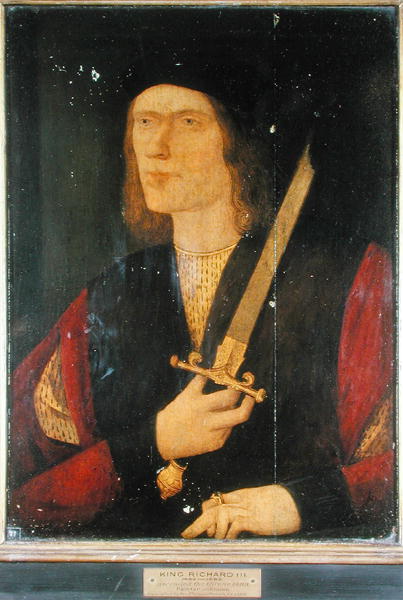

There are more than twenty portraits acknowledged to depict the last Plantagenet king of England.
These two are particularly of interest, as they are identified as mid- late sixteenth century copies of lost fifteenth century originals.
The dating of paintings is both science and art, incorporating history, details of costume, era, characteristics of brush strokes – and forensics, radio-carbon and dendrochronology dating. There is much in common with the identification of the Greyfriars, Leicester skeleton. In fact, it is tempting to surmise that the identification of bones is more exact than the identification of and dating of paint on canvas or wood panels. For one thing, DNA analysis doesn’t pertain to paint/wood/canvas. For another dendrochronolgy + radio-carbon dating are not necessarily exact.

Richard III – Broken Sword portrait (Source: Society of Antiquaries of London)
This has been dated to anywhere between 1518 and 1550. 1550 is favoured by some, as it was the time of publication of the “Sainted More’s” description of the hunchback with the withered arm. (Thomas More; 14 -15 , martyred by Henry (Tudor) VIII. More’s History of Richard III was influential in Shakespeare’s Richard III.) A broken sword can be interpreted as symbolic of failure; in a regal portrait, as symbolic of prematurely ended reign by violence, battle, deposition and usurpation. Note the narrow eyes, thin lips, deformed hand and somewhat clenched jaw. Obviously, not a trustworthy man….Richard III was an excellent target for Tudor propaganda reducing the usurped line of the Plantagenets to tyrants and debauches.

NPG 148; King Richard III by Unknown artist (Source: National Portrait Gallery)
This is my favourite portrait, as it was the inspiration for Josephine Tey’s detective in The Daughter of Time. As a result of Tey’s book, I was an ardent Ricardian for many years. Dendrochronology dates the work to c. 1590. Note the higher right shoulder suggesting some form of deformity in a portrait purportedly of the late Tudor era. (This format does not allow for graphically designing blood dripping from the highlighted name of Tudor….)
“There’s no art to find the mind’s construction in the face”.
Malcolm, act 1, scene IV MacBeth.
Perhaps not. Yet we will all react to immediate expressions in others as indications of their emotions in the moment. We will even designate a face in repose as “pleasant” or “shifty” or “mean”, or “benevolent” etc.
One of the contemporary (and considered to be most objective) descriptions of Richard III is that of “an itinerant knight from Silesia”. Niklas von Poppolau provided the following in his 1484 travel diary: “…a high-born prince, three fingers taller than I, but a bit slimmer and not as thickset as I am, and much more lightly-built; he has slender shoulders and thighs.” As with other contemporary descriptions, there is no reference to hunched back or withered arm.
Characters in The Daughter of Time react to the NPG portrait in sympathetic ways (to support the author’s thesis) to the question of the detective: what do you think of this face?
The Midget: “Liver.” A succinct nurse’s opinion.
The Surgeon: “Poliomyelitis.”
The Matron: “…the most desperately unhappy face that I have ever encountered…”
As to stature, the king was generally described as “small”. Professor Jo Appleby of the Leicester University team deduced from bone measurements that, without scoliosis, Richard III would have stood 5’8” (1.72m). The average male height today in North America is 5’8” – 5’10”. The degree of scoliosis reduced a man of good height to 1.61m. Definitely short with the spinal curvature.
As the king was continually described (as prince and king) as a great battle fighter, despite the slender build, also noted by Prof. Appleby, Richard III must have built up muscle, despite the pain of the pain of the disability. (A 15th century sword weighs between five and eight pounds. And both strength and balance must be adapted to the disability. Apparently, Usain Bolt also suffers from scoliosis.)
 NPG 148; King Richard III by Unknown artist (Source: National Portrait Gallery) |
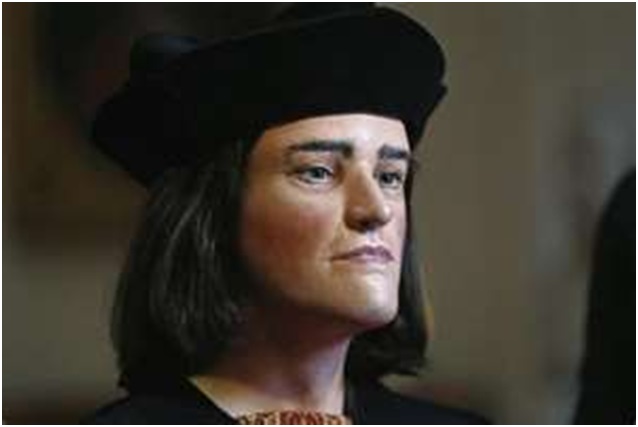 Richard III; skull reconstruction: Caroline |
Note the high cheekbones, prominent chin and not dissimilar set of the eyes and brows in these depictions. The nose of the portrait Richard is longer, with a shorter upper lip.
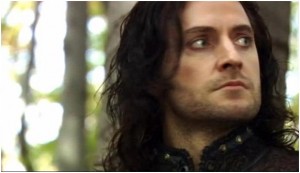
Richard Armitage (Robin Hood s3) – (Source: RANet.com)
The actor is clearly not a clone of either the portrait or of the reconstructed face. However, there is sufficient resemblance in the high cheekbones, prominent nose and delicately formed mouth for a convincing performance of the king. And many hope for the successful backing and funding for such a production to become a reality.
The perpetrator of this article descended down several rabbit holes in the process. I was sidetracked by:
- Fingerprint authentication of masterpieces;
- Dendrochronology – tree-ring dating….
- Questions pertaining to the effects of scoliosis, and the little information so far detailed by the Leicester project scientists…. more please!
- Niklas von Poppolau, “itinerant knight” from Silesia; invited to the court of Richard III; who was this man??? How did a foreign mere knight scrounge such an invitation???
It was sometimes difficult to remember what I thought was the focus of the article….but it was useful background.
SOURCES and REFERENCES
- Richard III: His Appearance; Carolyn Hammond, Richard III Society
http://www.richardiii.net.2_4_0_iii_appearance.php - Good King Richard? Jeremy Potter, 1983, reprinted by the Richard III Society
http://www.r3.org/bookcase/moremyth/html - Richard III: a study in medical misrepresentation. Isabel Tulloch for the Journal of the Royal Society of Medicine, Aug. 2009
http://jrsm.rsmjournals.com/content/102/8/315.full - Wikipedia – for general fact- and date-checking.
- Josephine Tey, The Daughter of Time; first published 1951 for some quotations.
This article was created by guest-blogger Fitzg !
– RIII-articles from the year 2012 – complete list of the year 2011 –
How to Be a ‘Good’ King
Reminder:
Today at 9 p.m. is the Channel 4
is the 2nd part of the Richard III documentary
about the researches leading to the discovery of the king!
(More information at the Channel4 website.)
♛ King Richard III ♛
King Richard’s history is preserved by the University of Leicester.
Therefore the University bought the painting of King Richard III depicting him at the Blue Boar Inn on the eve of the Battle of Bosworth which had been at auction at Gildings in Market Harborough:
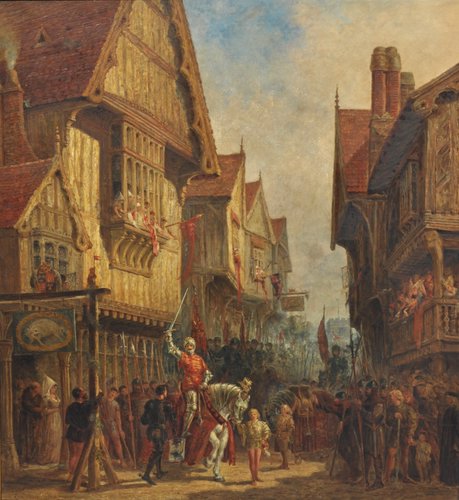
John Fulleylove: Richard III outside the Old Blue Boar Inn, Leicester
signed and dated (probably) 1880, oil on canvas 97 x 90 cm.
Credit: University of Leicester
Professor Sir Robert Burgess, Vice-Chancellor of the University of Leicester, about the purchase of the painting:
I am delighted that the University of Leicester has been able to acquire this work of art. A picture of Richard III at the Blue Boar Inn was a ‘must have’ for the University, especially as it was painted by a local artist, and is an accurate portrayal of the Inn and links to our world class research. It will be a valuable addition to our art collection.
Richard Buckley reveales more background about the importance of the painting:
In my view, Fulleylove has really brought to life the departure of Richard III from the Blue Boar on the morning of 21st August 1485. Although he could not have painted the inn from life, as the building had been demolished 40 years previously, Fulleylove based his picture on engravings by John Flower which are now known to be accurate representations of the building. The picture also shows All Saint’s Church in the background and gives an impression of what the other buildings of Leicester’s medieval High Street may have looked like at this time.
The artist John Fulleylove, an English landscape artist and illustrator, was born in Leicester in 1845. He originally trained as an architect.
His work was widely exhibited in England, e.g. at the prestigious London venues like the Royal Academy, Royal Society of British Artists, Fine Art Society, Royal Institute of Painters in Water Colours and the Royal Institute of Oil Painters.
He died at the age of fifty on 22nd of May 1908.
- BBC News Leicester: Richard III Blue Boar painting bought by university (27.02.2013)
Further news:
- A king might be anything, but boring. To this conclusion comes the following article in
The Guardian: Richard III – review, by Lyn Gardner (21.02.2013) – Might Shakespeare have helped King Richard III? - The next article is rather – how to be a good journalist and good academic, treating a good/bad/worse/brave king:
The Guardian: King Richard III was a press man’s dream, but the furore drew criticism, by Ather Mirza (22.02.2013) – Was the presentation of the research and results about King Richard III done in the right way? Position of Ather Mirza, director of the University of Leicester News Centre, who has ably performed the difficult task to bring over 150 journalists from all over the world to come to Leicester for King Richard III.
I commented on the mentioned ciriticism of the UoL on my fan-blog here. - Daily Mail: The signature of a teenage king in waiting: 550-year-old hand-written book is signed by Richard III and contains his personal motto, by Olivia Williams (22.02.2013) – Manuscript with the handwriting of a young future King Richard III on display.
- Express.co.uk: Descendants of King Richard III ruled the free world, by Ian Read (24.02.2013) – Genealogist Anthony Adolph claims, that thousands of relatives of King Richard III are spread around the world and most are yet unaware of their royal ancestry. Before that background a poll might be necessary to come to a majority decision, rather than a letter of 9 relatives, claiming to speak with the voice of King Richard III and demanding York as last burial place for their ancestor.
- ITV: Rare book signed by Richard III goes on display (26.02.2013) – See the original signature of the young Richard III, at that time Duke of Gloucester.
♛ Battle of the Cities ♛
The next topic I unfortunately can’t present entirely unbiased. Because for me, the open letter of the relatives opens many more questions than it solves.
Relatives taking a stand in regard to the burial place for King Richard III opens questions and none of them even close to solving the questions about King Richard III himself, but rather what we see as the prerogative of relatives.
In a time, where we discuss, if relatives may decide when to turn off medical machines or take a needed decision at hospital, even when they are close kin like children or spouse, how can a decision by a group of relatives after about 17 generations look like, who could decide, who not, what degree of relation would have the more weight in a decision making process,…
So I rather stick with a poll among all found relatives, while it may take a while to find all.
And that still leaves the question unanswered, if the degree of relation should be taken into account and how it should be weighed in the decision making process.
You see, I did not even come to mention King Richard III, as I see the procedure from relatives problematic in itself, especially their statement:
With due humility and affection, we are and will remain his Majesty’s representatives and voice.
That is not to say that I am against York or against Leicester or for London or Westminster or Windsor or Middleham or …
Just that the method is not such a straight forward and clear one as the headlines of the newspaper articles make believe.
- Daily Mail: Richard III’s descendants demand York burial: Nine of his descendants oppose plans to bury him at Leicester Cathedral next year, by Daily Mail Reporter (25.02.2013)
- ITV: Bid to have Richard III buried in York gains momentum (25.02.2013)
- ITV: Richard III’s descendants call for York burial (25.02.2013)
I even find the whole discussion about the cities problematic, so I want to publish a letter, Roswitha sent out to requests to instrumentalize our website in the fight for York. Roswitha expresses so well, why we don’t take position in the battle of the cities:
[…] In the question about the cities, we remain neutral and don’t have any influence on the decision regarding the burial place for King Richard III.
We also don’t want to try to influence the decision, as it is a decision the towns and their citizens must come to terms with, as directly or indirectly they will fund the decision with their tax money.
Our initiative and website instead is a worldwide connection of fans of Richard Armitage, who in my opinion do not have a right to take the power of their global network to influence an ‘English’ decision.
As far as I know, the decision for Leicester was made early on and its settlement was pre-condition for the University of Leicester to even agree to start the archaeological research. This was at a time when nobody except Philippa Langley even believed in the possibility of really finding the remains of King Richard III.
As King Richard III was a historical aspect most towns so far did not hold too high in their esteem, so e.g. the Richard III museum in York is a privately founded and held museum, it is a strange thing that the towns now are fighting over him. Though I also see the beneficial aspect of it for marketing King Richard III right now.
Tourist streams and the consequential money are the major motivator for most competitors in the fight for the remains of King Richard III, so I would not see that aspect as a possibility to discern between the competitors.
I personally am much more interested in a good and well researched presentation of the story of King Richard III in each town, than in the fact whichever town will get the burial place. Eventual research grants to find out more about the town’s story in relation to King Richard III and a good exhibition of the finds would do a great deal to enhance each of the fighting towns’ status as an authority to speak about King Richard III.
So also would a film do much to promote a new view and closer look at the life and times of King Richard III by a wider audience and that is the reason why we try to show our support with our petition to help a film to be made.
I hope this can appease a bit your feelings about the towns and their fighting.
Thank you very much for giving us your feedback. We cherish and value your opinion and feedback very much.
[…]
A Historical Chance…
♕ Fall in Splendour ♕
The schedule is set for our collective reading of
“The Sunne in Splendour” by Sharon Kay Penman.
Fanny/iz4blue has announced the details on her blog!
Distracted Musings of one ReAlity
If you want to join in and still need a copy of the book, please consider to make your purchase via the link at RichardArmitageNet.com, where reference fees will go to the charities selected by Mr. Armitage. Thank you!
Amazon.co.uk – Amazon.com Print & Kindle edition
Reference fees gained through links at the KRA website also go to the RA-charities.
♛ KRA Solutions 2012 ♛
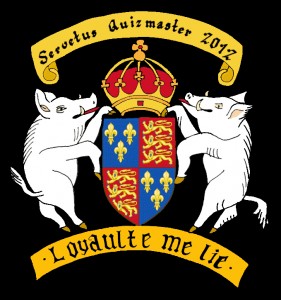
Servetus, our quizmaster of the KRA Quiz 2012, has a wonderful collection of information about and around the correct answers and where the solutions to the scavenger hunt can be found.
It is a wonderful collection of information about Mr. Armitage and King Richard III and interesting to read, even if you did not try the scavenger hunt:
King Richard Armitage Week 2012 puzzle solution [sources]
♕ Leicester News ♕
For all of us, who can’t attend tomorrow’s opening of the Leicester carpark to see the archaeological progress for themselves, the University of Leicester publishes updates and news. Here the latest very promising news of today: University of Leicester
Ms. Philippa Langley describes the latest finds in Leicester:
The discovery of Herrick’s garden is a major step forward and I’m incredibly excited. In locating what looks like one of the garden’s pathways and, potentially, its central area which could have once held the three foot stone pillar marking the location of King Richard’s grave, we could be that bit closer to finding the resting place of Britain’s last warrior king.
Here are some images and examples of the finds:
 Philippa Langley, from the Richard III Society, in Herrick’s garden. (Image credit – University of Leicester) |
The official announcement of the opening day tomorrow, 8th of September, 2012 from 11 a.m. till 2 p.m., by the Leicester City Council.
King Richard Month in June & Further News
We had a King Richard Week in August last year, but one week is not nearly enough for King Richard.
The Russian Richard Armitage fan-site Armitage-Online has made June a whole King Richard Month with their wonderfully creative calendar creations:
(More images and the large scale versions are available here and by clicking on the preview image.)
King Richard III is alive
and will return to his home castle Middleham this coming weekend.
You don’t believe me?
See for yourself: Announcement at the English Heritage website
To get an audience with the king himself, reserve your spot!
More details and information how to book can be found at the
Our King still is occupied
with fighting a dragon and for another kingdom, as the 7th pre-production video by Sir Peter Jackson about the filming of “The Hobbit” shows:
Video available on Facebook: openly available Facebook-Link
King Richard III – A Bag for a King
Last week we linked to images, CDoart had created for King Richard Armitage.
She also has created a bag for herself and got some requests where that bag could be ordered. So she made it available and published the order-link in the comments to the article on her blog.
CDoart does not want to make any profits by making her ‘Petition King Richard Armitage’ bag available, but will give all commission fees and income generated through sales via Zazzle to charities specified or yet to be specified by Mr. Armitage.
Under those circumstances we feel comfortable to link to her bag and sales options as well:
The bag can be ordered via Zazzle.com (where also more details about the bag are available).
Matthew Ryan and the Illustration of King Richard III’s time
I don’t promise too much, when I announce our next interview guest as the man who really makes history visible.
How is that possible, you will likely ask, but with extensive research and lifelong exercise and even archery training as background, Mr. Matthew Ryan as well has the experience as the talent to bring the time of King Richard back in full colour.
Here now our interview with Historical Illustrator
Matthew Ryan
Thank you for joining us today and sharing your wonderful artwork with us.
What especially interests us is, how did you come to do historical illustrations?
I have always drawn and painted for as long as I can remember and as a boy most of my pictures were of knights and battles (though not very historically accurate back then). I loved the work of John Howe and Alan Lee [KRA-Comment: Those two artists will especially interest all Tolkien- and “The Hobbit” fans.] and was also very inspired as a child by the Illustrations of Knights by Julek Heller.
After leaving School I studied for a H.N.D. in Visual Communications and also did a Degree in Illustration. I then worked for eleven years as a traditional signwriter/advertiser and although I enjoyed my work it was not what I wanted to be doing.
All this time however I was reading history books and visiting places of historic interest. History has always been a passion of mine especially the medieval period.
I have also shot Longbows for most of my life and for the past few years Warbows, I took much inspiration from reading books by people such as Hugh Soar
, Robert Hardy
and Anne Curry
and also seeing how people like Simon Stanley, Mark Stretton and Steve Stratton draw back the heavy bows. I find that making and shooting my own arrows gives me a small but real connection to the thoughts and ideas of our ancestors and is a good indirect inspiration to my work.
All these influences took me to where I am today and I put my two greatest passions together, art and history and now work as an historical Illustrator. I now find the pictures that I am producing are a lot more productive because I am illustrating something that I am passionate about.
What methods of painting / drawing do you like best or prefer to use?
I love working with most materials but my favourite is oil paint, as this really lets me put a lot of depth and detail into my work. I also like working in just pencil and enjoy the simple nature of that medium.
What are your favourite topics for your paintings?
I am inspired by painting big and fantastic events from the past featuring kings and people of note but I also love to portray the common person in quieter pictures and try to give an insight into the day to day life of people of that time. Emotion is something I love to get into my pictures so I try to show that in my work and I think it helps to bring the pictures to life.
What is your favourite historic timeframe and why is that so?
Because of my love of archery it has to be the Hundred Years War but visually I enjoy the style of armour and clothing from the times of The Wars of the Roses and am fascinated by the drama of this period.
Here on KingRichardArmitage, with all the historical interest showing up around Mr. Armitage’s mentioning of King Richard III, we are naturally curious, where you get your sources and material for your artwork. How do you research details about a certain time to depict in your illustrations?
I research in many different ways depending on what I am painting. I try to base much of what I do on contemporary illustrations although this in its self can be fraught with many problems. For details of armour I find viewing carvings on tombs and going to museums very useful and I also visit various re-enactments. Often research and reading takes more of my time than the painting, but the more information and answers I have on a subject the easier the painting is to produce. Speaking to historians is of course a great help and my thanks go out to those who have already given me help and direction.
Mr. Ryan, you gave us wonderful examples of your work to post together with your interview here on KingRichardArmitage. Where can we find further information about you and your creations?
I do not yet have my own website but people are welcome to view my work on my Facebook page at…
matthewryanhistoricalillustrator @facebook.com
and I can be contacted at…
matthewryanhistoricalillustrator@LIVE.CO.UK
You let us know, that your next main project will be about King Richard III and the Battle of Bosworth. Why Bosworth and what interests you in King Richard III and his time?
Many things fascinate me about the Battle of Bosworth and King Richard, it is something I hope to base much of my future work on. I find it very inspiring that a King will put himself in mortal danger by leading from the front and fighting amongst his enemies.
I enjoy illustrating historic themes that history may have misinterpreted or unjustly portrayed in the past and Richard III certainly in my opinion fits this bracket.
Your paintings are no mere depictions of a time, but tell a whole and colourful story about fate and life on their own. So let me ask, what is your intention with your artwork about King Richard III and by giving colour to a time long past?
I wish to produce a painting that honours the memory of our last Plantagenet King, the last King to die on the field of battle and a King that has no tomb as a final resting place. I hope when complete the picture does him some justice and may serve as an inspiration for others to find out more about him.
An inspiration your artwork indeed is and it is a joy to discover your creations, which so well revive the past. I hope you will keep us updated on your project about King Richard III and the Battle of Bosworth. We love to hear and see more about your wonderful and well researched painting projects.
Thank you very much for the interview and taking the time to talk with us, Mr. Ryan.
The link to Mr. Ryan’s picture galery on Facebook:
To get in contact with Mr. Ryan:
matthewryanhistoricalillustrator@LIVE.CO.UK
Further News about King Richard III:
Maria Grazia (Fly High!)- Interview & Giveaway with Cecilia Latella about Richard III
Maria Grazia posted an interview with artist Cecilia Latella about her comic book “The Boar“, depicting the life and fate of King Richard III. Cecilia Latella speaks about her way to King Richard III and has some very interesting reading tips for new and advanced King Richard fans.
Leave a comment at her blog post till March 5th, 2012 to enter the giveaway contest for either a free Italian (print book) or an English (e-book) version of the comic book “The Boar” by Cecilia Latella.
Merry Christmas and Happy Holidays
Dear readers and supporters of King Richard and Richard Armitage,
Alfie did a wonderful fan-art especially for Christmas and I just need to post it here on this blog as well:
(Preview of the picture here. For full view, please follow this link or click on the picture to reach Alfie’s blog post with the larger picture.)
After seeing that picture, there can not possibly be any doubt left. Mr. Armitage just is the true King Richard III.
Merry Christmas and have wonderful, relaxed and enjoyable holidays!
P.S.: We will be back with book recommendations and authors’ interviews after Christmas, so spare some of your book vouchers you get as Christmas presents!

